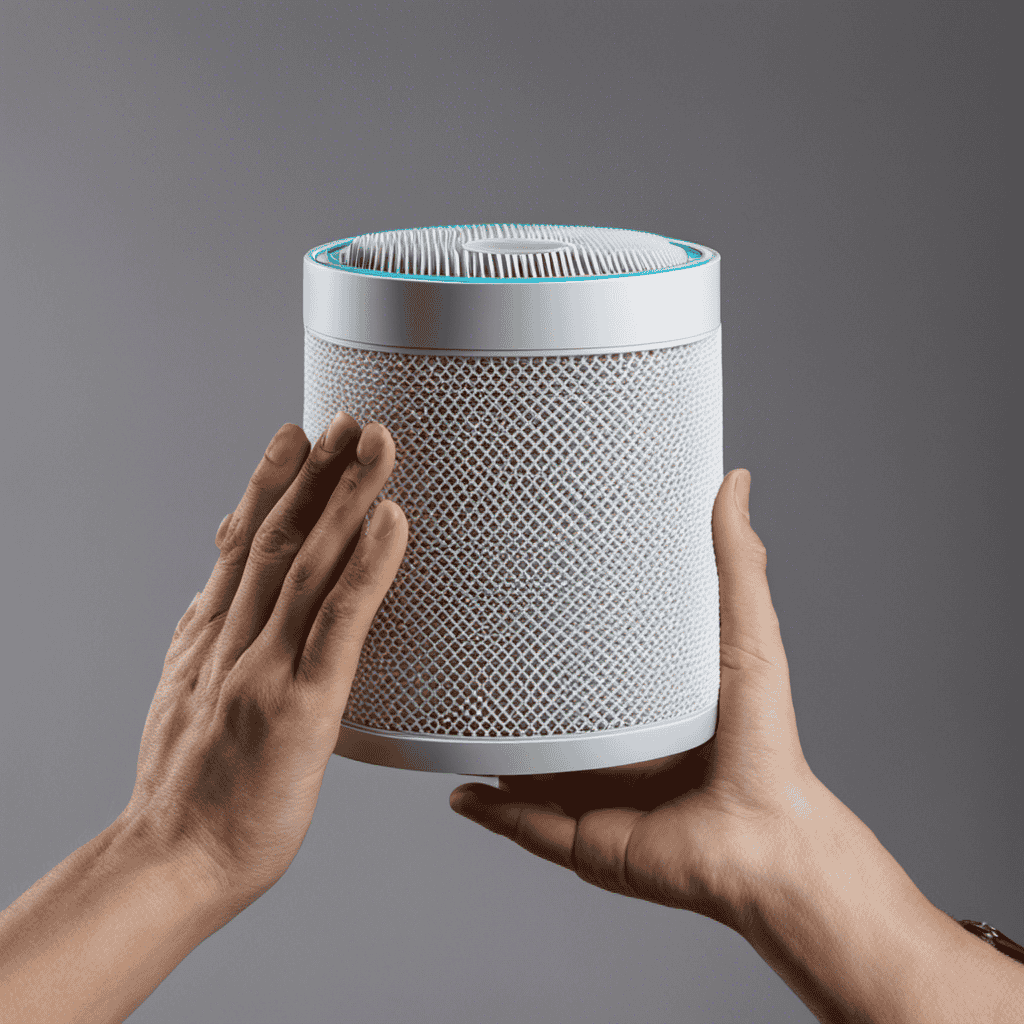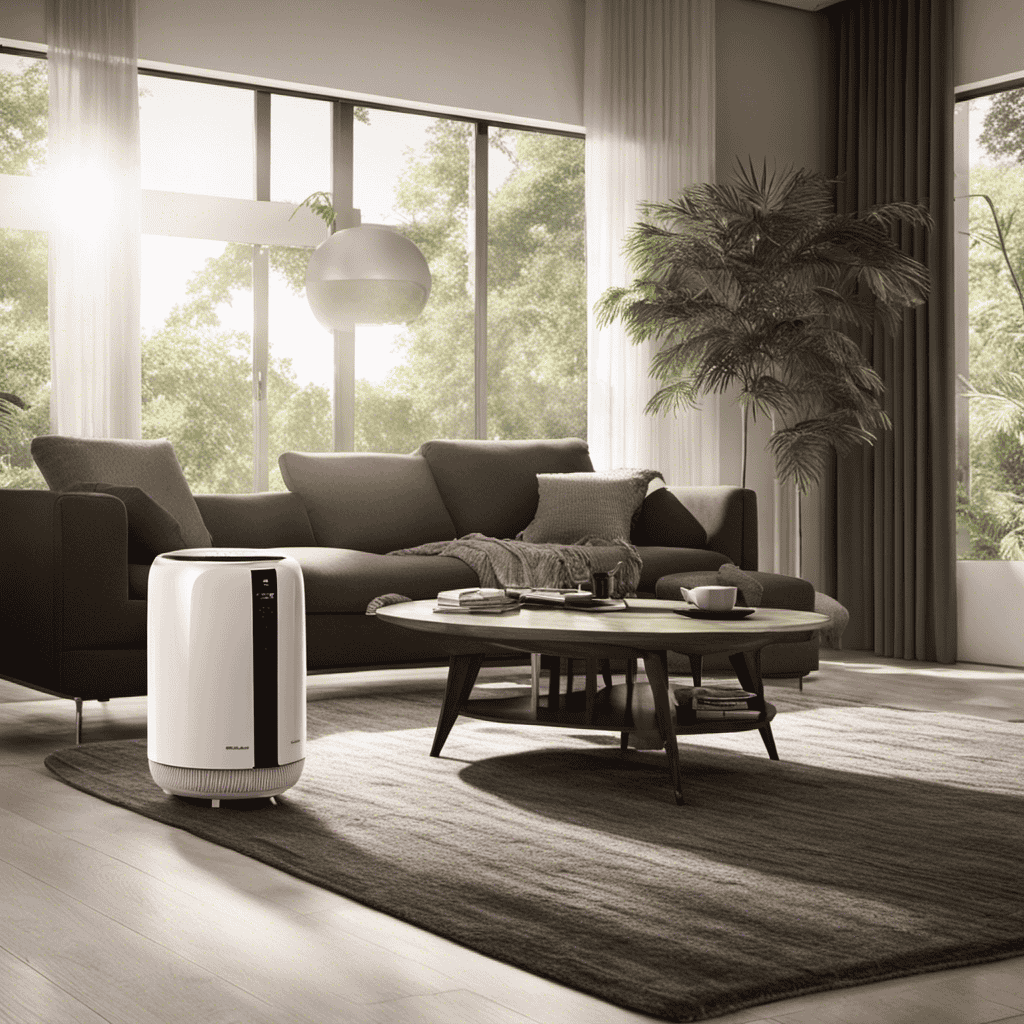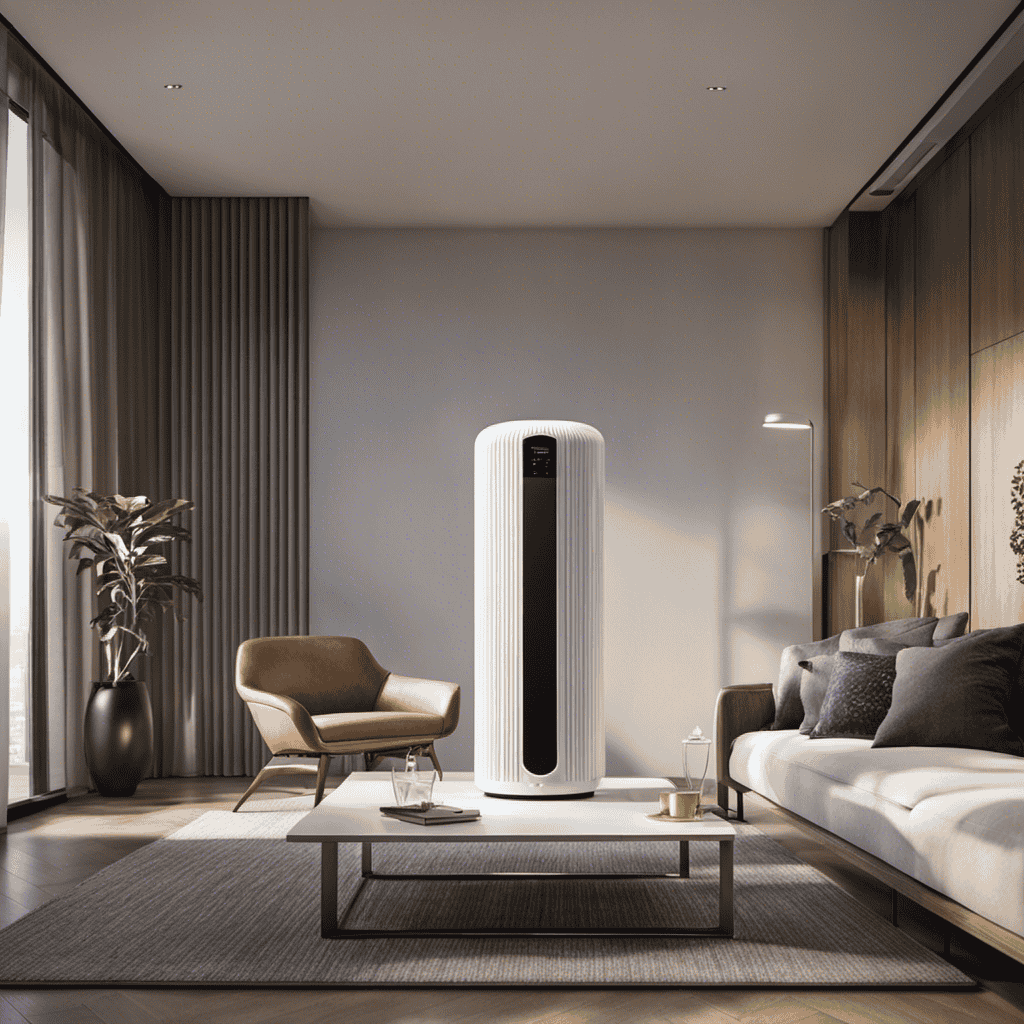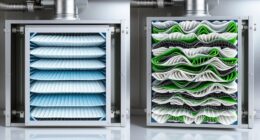To combat wildfire smoke indoors, monitor air quality with sensors and keep windows and doors closed during high smoke periods. Seal gaps around vents and use HEPA air purifiers to filter out harmful particles. Maintain your HVAC system with clean filters, and add houseplants like spider plants to naturally improve air quality. Minimize indoor pollution sources and prepare emergency supplies. Continuing helps you discover more effective strategies to keep indoor air safe and clean.
Key Takeaways
- Use high-efficiency HEPA filters and air purifiers to trap wildfire smoke particles indoors effectively.
- Keep windows and doors closed during smoke events to prevent outdoor pollutants from entering.
- Seal gaps around windows, doors, and vents with caulk or weatherstripping to block smoke infiltration.
- Monitor indoor air quality with sensors and activate ventilation or purifiers when smoke severity increases.
- Create a shelter by sealing the space, using air filters, and minimizing sources of indoor pollution for optimal protection.
Monitor Air Quality and Stay Informed
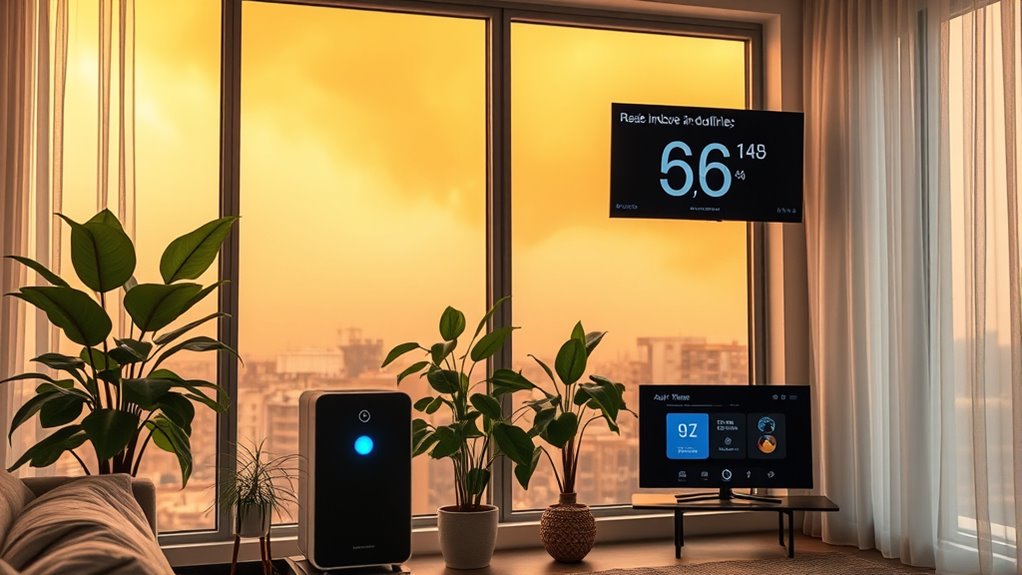
Since wildfire smoke can quickly worsen indoor air quality, staying informed about current conditions is essential. Using air quality sensors allows you to continuously monitor pollution levels inside your home. These devices detect harmful particles and pollutants, giving you a clear picture of your indoor environment. Many sensors offer real-time alerts, notifying you immediately when air quality deteriorates. This instant feedback helps you take prompt action, like increasing ventilation or activating air purification systems. Additionally, understanding air quality monitoring concepts can help you select the most effective air purification solutions for your needs. For example, some sensors are compatible with air purifiers, enabling automated responses to changing air quality. Regularly checking these sensors can also help identify pollution sources, enabling you to address specific indoor contaminants more effectively. Using monitoring devices can also help you evaluate the effectiveness of your air purification efforts over time. By regularly checking these sensors, you can better manage indoor air and minimize health risks. Staying proactive with real-time alerts ensures you’re aware of changes and can respond swiftly to protect your indoor air quality during wildfire seasons.
Seal Gaps and Cracks to Prevent Smoke Intrusion

Sealing gaps and cracks around your home is an essential step in preventing wildfire smoke from seeping indoors. You can caulk gaps around windows, doors, and vents to block smoke entry. Weatherstripping cracks on doors and windows creates a tight seal, reducing airflow and safeguarding your indoor air quality. Taking these actions keeps harmful smoke out and maintains a cleaner, healthier environment inside. Additionally, ensuring that all skincare patches are properly applied can help protect your skin from environmental irritants, including smoke particles. Incorporating air filtration devices can further improve indoor air quality by capturing lingering smoke pollutants. Understanding projector technology can also help in selecting the right devices to monitor indoor air quality effectively. Remember to check for air quality monitors that can provide real-time data and alert you to indoor pollution levels.
Use HEPA Air Purifiers for Effective Filtration

HEPA air purifiers are highly effective at capturing wildfire smoke particles, improving indoor air quality quickly. When choosing a purifier, consider the room size and CADR ratings to guarantee ideal filtration. Selecting the right device can make a significant difference in keeping your indoor air cleaner during wildfire events. Additionally, look for models with multi-functionality, such as UV light or ionizers, to enhance overall air purification. Incorporating air quality indicators can help monitor the effectiveness of your air purifier and ensure optimal performance. Regular maintenance and filter replacement are also essential to sustain filtration efficiency over time. For added assurance, consider checking the support hours of your chosen device’s manufacturer to access assistance if needed. Utilizing advanced filtration technology can further improve air purification capabilities during smoky conditions.
HEPA Filtration Effectiveness
Are you aware of how effective HEPA air purifiers can be in reducing wildfire smoke indoors? HEPA filters capture at least 99.97% of airborne particles as small as 0.3 microns, including smoke particles, making them highly efficient. To maintain their filtration power, you need to prioritize regular air purifier maintenance, especially adhering to the filter replacement schedule recommended by the manufacturer. A clogged or dirty filter decreases efficiency and can even circulate trapped pollutants back into your indoor air. Using a purifier with a properly maintained HEPA filter ensures maximum removal of harmful particles, improving indoor air quality during wildfire events. Regular filter replacement is essential for consistent performance, as it prevents small particles from bypassing the filter. Filter longevity is a key factor in ensuring your air purifier continues to provide cleaner, safer air for you and your family. Additionally, understanding air quality standards can help you better assess the effectiveness of your filtering solutions.
Choosing the Right Purifier
Choosing the right air purifier is a key step in effectively reducing wildfire smoke indoors. To guarantee top-notch performance, focus on choosing filter types that target smoke particles and allergens. Here are four tips to guide your selection:
- Opt for HEPA filters, as they capture 99.97% of airborne particles, including smoke.
- Check for proper sizing—your purifier should match your room’s square footage for maximum efficiency.
- Prioritize ease of air purifier maintenance, like replacing filters regularly to keep filtration effective.
- Research purifier features, such as filter indicator lights, to help you stay on top of filter changes and maintain cleaner air indoors.
- Consider the impact of filtration efficiency when selecting a purifier, as higher efficiency models will better remove wildfire smoke and fine particles from indoor air. Incorporating filter material quality can further enhance the purifier’s ability to capture microscopic particles effectively.
Keep Indoor Windows and Doors Closed During High Smoke Periods

When wildfire smoke levels are high, keeping your windows and doors closed is one of the most effective ways to prevent harmful particles from entering your home. Proper window insulation helps block airborne pollutants and maintains a barrier against smoke infiltration. While natural ventilation is beneficial in normal conditions, during smoke events, opening windows can pull in hazardous particles. Sealing gaps and ensuring your windows and doors are tightly closed minimizes indoor air contamination. Remember, even small leaks can let in smoke, so check weatherstripping and seals regularly. Additionally, automation technology can assist in monitoring indoor air quality and alerting you when ventilation is necessary. Advancements in AI-powered air quality monitors can provide real-time data to help you manage indoor air more effectively. Using portable air purifiers with HEPA filters can further improve indoor air quality during smoke events. Regularly updating your home’s ventilation systems ensures optimal performance and protection against smoke infiltration. Incorporating air quality sensors can help detect smoke particles early and trigger automated responses to safeguard indoor air. Avoid relying on natural ventilation during high smoke periods, and instead, focus on sealing your home to keep the indoor air cleaner.
Improve Ventilation With Clean, Filtered Airflow

While keeping windows and doors shut prevents outdoor smoke from entering, it can also cause indoor air to become stale and buildup pollutants. To improve ventilation with clean, filtered airflow, focus on airflow optimization and your ventilation systems. Here are four ways to do this:
Keeping windows closed prevents smoke entry but can cause indoor air stagnation; optimize ventilation for cleaner, safer air indoors.
- Use exhaust fans in kitchens and bathrooms to remove indoor pollutants.
- Install or upgrade ventilation systems with HEPA filters for cleaner airflow.
- Use portable air purifiers to supplement existing ventilation.
- Maintain proper airflow by ensuring vents are unobstructed and functioning correctly.
- Be mindful of filtration systems, which play a crucial role in capturing allergens and fine dust from the air. Additionally, integrating air exchange rates can help optimize indoor air quality by balancing fresh air intake with pollutant removal. Regularly monitoring and adjusting ventilation performance can further enhance air quality during wildfire events. Ensuring proper airflow management is essential for maintaining a healthy indoor environment during smoky conditions.
These steps help circulate fresh, filtered air indoors, reducing pollutant buildup and making your space safer during wildfire smoke events. Proper ventilation ensures you get cleaner air without letting outdoor smoke in.
Maintain HVAC Systems With Proper Filters and Regular Checks

Regularly maintaining your HVAC system is essential for ensuring it effectively filters indoor air during wildfire smoke events. Start with air filter maintenance by replacing or upgrading to high-efficiency filters designed to capture smoke particles. Check filters monthly and change them as needed to prevent buildup and maintain airflow. An HVAC inspection is equally important; schedule professional inspections to verify that your system operates properly and that filters are properly installed. Clean coils, ducts, and vents during inspections to optimize performance. Well-maintained filters and regular checks help your HVAC system remove harmful particles, improving indoor air quality. Additionally, understanding the importance of filtration and pump protection can help you select the right filters and filters to prevent system clogging and ensure consistent performance. Regularly inspecting filter indicators can alert you to replacement needs before performance declines. Staying on top of these tasks ensures your system functions efficiently and protects your indoor environment from wildfire smoke pollution.
Minimize Indoor Pollution Sources

To effectively reduce indoor pollution during wildfire events, you need to identify and limit sources of indoor contaminants. Indoor pollutant sources, like household cleaning products and everyday activities, can worsen air quality. Here are four ways to cut down on these pollutants:
- Choose natural or unscented cleaning supplies to reduce chemical emissions.
- Avoid aerosol sprays and air fresheners that release volatile organic compounds (VOCs).
- Keep windows closed during smoky days to prevent outdoor pollutants from entering.
- Regularly clean and dust to minimize dust, pet dander, and mold, which can worsen indoor air quality.
Create a Safe Indoor Environment With Houseplants and Natural Air Cleaners

Creating a healthier indoor environment during wildfire events can be as simple as adding houseplants and natural air cleaners. Indoor plant care is essential to keep your plants thriving and effective at filtering air. Choose natural air purifiers like spider plants, snake plants, or pothos, known for their ability to remove toxins from the air. Place these plants in well-lit areas, and water them appropriately to ensure they stay healthy. Not only do they improve air quality, but they also add a calming touch to your space. Regularly dust the leaves to maximize their filtering ability. Incorporating houseplants and natural air purifiers into your home creates a cleaner, safer indoor environment, helping you breathe easier during wildfire smoke events.
Prepare Emergency Supplies and Know When to Seek Shelter

Make sure you have an emergency kit with essentials like masks, water, and medicines ready to go. Learn how to recognize different smoke severity levels so you know when to seek shelter immediately. Follow proper shelter protocols to stay safe and minimize smoke exposure during a wildfire event.
Essential Emergency Kit Items
When wildfire smoke worsens indoors, having a well-stocked emergency kit becomes essential. This ensures you’re prepared and can act quickly if air quality deteriorates. Key items include:
- Air quality sensors – Help you monitor indoor air and decide when to seek shelter.
- N95 masks – Provide personal protection from harmful particles.
- Bottled water and non-perishable food – Ensure you stay nourished during prolonged smoke events.
- Flashlights and batteries – Keep your emergency preparedness plan on track if power goes out.
Having these items ready allows you to respond swiftly and maintain cleaner indoor air. Regularly check and update your emergency kit to stay prepared for worsening wildfire smoke conditions.
Recognizing Smoke Severity Levels
Monitoring indoor air quality is vital as wildfire smoke conditions change. Use air quality sensors to track smoke severity levels inside your home. These devices can detect dangerous particulate matter and alert you when air quality worsens. Recognizing the severity of smoke helps you decide when to take action, such as increasing filtration or seeking shelter. During low smoke severity, ventilation might be safe, but if sensors show high particulate levels, it’s time to tighten indoor air controls. Smoke severity can fluctuate quickly, so stay alert to sensor readings and air quality reports. Understanding these levels empowers you to make informed decisions, ensuring your indoor environment remains as safe as possible during wildfire events.
Proper Shelter Protocols
To stay safe during wildfire smoke events, it’s essential to prepare an emergency kit with supplies like masks, bottled water, medications, and important documents. Proper shelter setup and safety protocols help protect you indoors. Keep your shelter well-sealed by closing windows, vents, and doors, and use high-efficiency filters if available. Know when to seek shelter—move indoors at the first sign of smoke and stay there until air quality improves. Here are four key steps:
- Stock up on N95 masks for filtering indoor air
- Gather bottled water and non-perishable food
- Prepare a flashlight and batteries
- Keep essential medications and documents easily accessible
Following these shelter protocols minimizes smoke exposure and ensures you’re ready to act swiftly.
Frequently Asked Questions
How Often Should I Replace Air Filters During Wildfire Season?
During wildfire season, you should replace your air filter more frequently than usual. Typically, filters last about 90 days, but during wildfire season, it’s best to change them every 30 to 60 days to maintain ideal air quality. The increased smoke and pollutants reduce the air filter lifespan, so staying vigilant ensures your indoor air stays clean and healthy, protecting your lungs and overall well-being.
Can Indoor Plants Really Improve Air Quality During Smoke Events?
Indoor plants can improve air quality during smoke events by offering natural air purification. Plant varieties like snake plants, pothos, and spider plants are especially effective at filtering toxins and particulates from the air. You should place multiple plants around your home for better results, and keep them healthy with proper watering and light. While they help, don’t rely solely on plants—use air purifiers and improve ventilation for ideal indoor air quality.
Are There Specific Materials to Avoid to Reduce Indoor Pollution?
Imagine opening a window, only to invite more pollutants inside—you’re right to ask about materials to avoid. You should steer clear of toxic furnishings and synthetic materials that release volatile organic compounds (VOCs). These can worsen indoor air quality, especially during smoke events. Opt for natural, low-emission materials like untreated wood or organic fabrics. By choosing wisely, you create a safer, healthier space for you and your family.
How Can I Tell if My Indoor Air Quality Is Safe?
You can tell if your indoor air quality is safe by using air quality sensors, which monitor pollutant levels in real-time. Pay attention to signs like lingering odors, dust buildup, or allergy symptoms. Identify indoor pollutant sources such as smoke, pet dander, or cleaning products. Regularly checking sensor readings helps you spot problems early, so you can take action, like improving ventilation or reducing pollutant sources, ensuring healthier indoor air.
What Are the Best Practices for Venting Smoke Outside Safely?
To vent smoke outside safely, you should position your exhaust fan near the smoke source and make certain it’s directed toward an outdoor vent. Proper exhaust fan placement helps remove indoor smoke effectively, while outdoor vent barriers prevent smoke from re-entering your home. Always check that vents are unobstructed, and use dampers or covers if needed, especially during high winds, to maintain safe and efficient smoke venting.
Conclusion
By following these simple yet powerful tips, you can turn your home into an impenetrable fortress against wildfire smoke. Staying vigilant and proactive might not make you invincible, but it’ll certainly make your indoor air quality as pristine as a mountain spring. Don’t underestimate the power of these strategies—think of them as your personal shield against the invisible enemy. With these steps, you’ll breathe easier, knowing your sanctuary remains safe and breathable, no matter how fierce the wildfire season gets.



